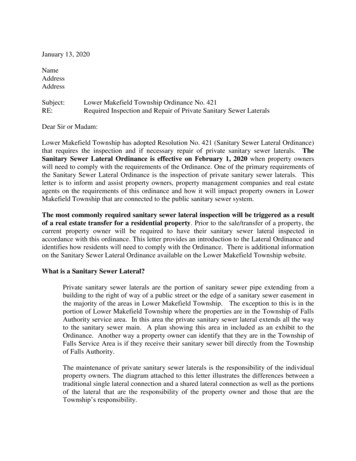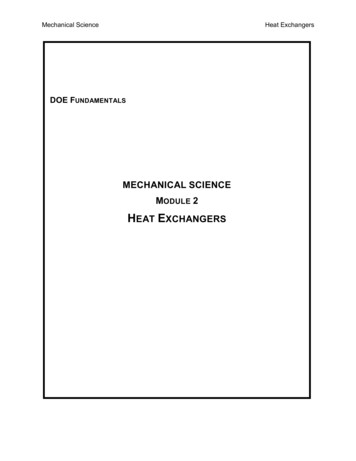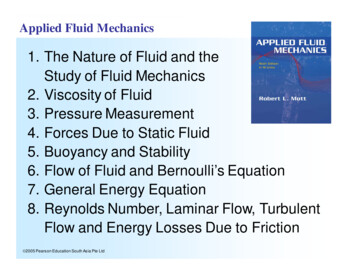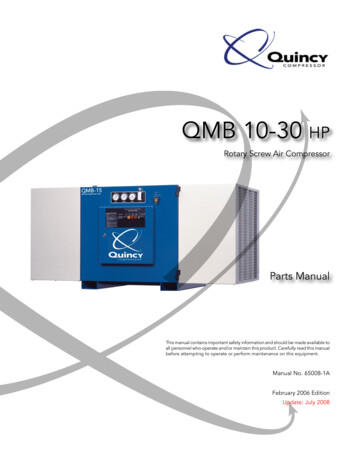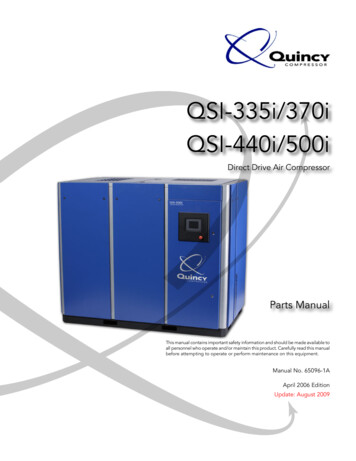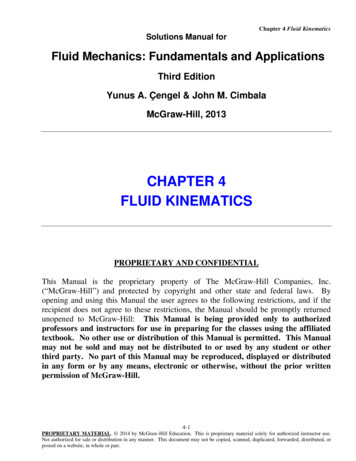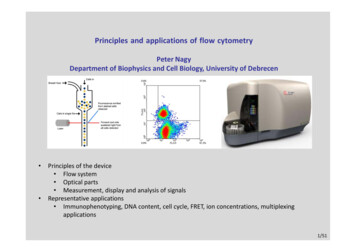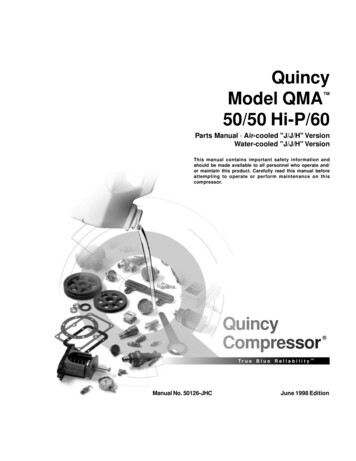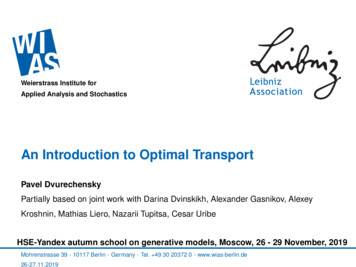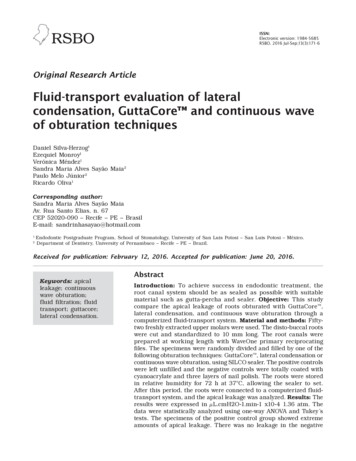
Transcription
ISSN:Electronic version: 1984-5685RSBO. 2016 Jul-Sep;13(3):171-6Original Research ArticleFluid-transport evaluation of lateralcondensation, GuttaCore and continuous waveof obturation techniquesDaniel Silva-Herzog1Ezequiel Monroy1Verónica Méndez1Sandra Maria Alves Sayão Maia2Paulo Melo Júnior2Ricardo Oliva1Corresponding author:Sandra Maria Alves Sayão MaiaAv. Rua Santo Elias, n. 67CEP 52020-090 – Recife – PE – BrasilE-mail: sandrinhasayao@hotmail.com12Endodontic Postgraduate Program, School of Stomatology, University of San Luis Potosi – San Luis Potosi – México.Department of Dentistry, University of Pernambuco – Recife – PE – Brazil.Received for publication: February 12, 2016. Accepted for publication: June 20, 2016.Keywords: apicalleakage; continuouswave obturation;fluid filtration; fluidtransport; guttacore;lateral condensation.AbstractIntroduction: To achieve success in endodontic treatment, theroot canal system should be as sealed as possible with suitablematerial such as gutta-percha and sealer. Objective: This studycompare the apical leakage of roots obturated with GuttaCore ,lateral condensation, and continuous wave obturation through acomputerized fluid-transport system. Material and methods: Fiftytwo freshly extracted upper molars were used. The disto-buccal rootswere cut and standardized to 10 mm long. The root canals wereprepared at working length with WaveOne primary reciprocatingfiles. The specimens were randomly divided and filled by one of thefollowing obturation techniques: GuttaCore , lateral condensation orcontinuous wave obturation, using SILCO sealer. The positive controlswere left unfilled and the negative controls were totally coated withcyanoacrylate and three layers of nail polish. The roots were storedin relative humidity for 72 h at 37 C, allowing the sealer to set.After this period, the roots were connected to a computerized fluidtransport system, and the apical leakage was analyzed. Results: Theresults were expressed in µL.cmH2O-1.min-1 x10-4 1.36 atm. Thedata were statistically analyzed using one-way ANOVA and Tukey stests. The specimens of the positive control group showed extremeamounts of apical leakage. There was no leakage in the negative
172 – RSBO. 2016 Jul-Sep;13(3):171-6Silva-Herzog et al. – Fluid-transport evaluation of lateral condensation, GuttaCore and continuous wave of obturation techniquescontrols. The statistical analysis indicated that continuous waveobturation and GuttaCore showed lower leakage than the lateralcondensation technique (p 0.05). No difference was found among thecontinuous wave obturation and GuttaCore (p 0.05). Conclusion:Continuous wave obturation and GuttaCore showed lower leakagethan the lateral condensation technique. There was no differencebetween the continuous wave obturation and GuttaCore . The fluidtransport system used in this study allowed an accurate quantitativemeasurement of leakage using simpler equipment.IntroductionA properly shaped and disinfected root canalsystem is an environment in which the bacterialcommunities have been disrupted or eliminated,ensuring that the environment is, unable topromote or sustain periapical disease. Themethod of preserving this condition over time isby hermetically filling the duct system.Gutta-percha, derived from resin of Sapotaceaetree family shows most of the characteristics ofan ideal sealing material. In its chemically purestate, occurs in two phases: α- found naturallyand β- a result of refining, is the predominantphase in dental materials [4]. These phases areinterchangeable, depending on the temperature ofthe material.The lateral condensation of gutta-percha hasbeen widely used for decades and is consideredthe gold standard in most scientific publications.It is relatively simple, provides good control of theapical sealing level and requires only conventionalinstruments without the need for an apparatus orcomplex equipment [3].The continuous wave obturation technique,introduced by Buchanan, is very similar toSchilder’s vertical condensation; it uses a heatsource or carrier associated with tips of differenttapers of 4, 6, 8, 10 and 12%, graduated in 5 mmintervals, which allow rapid heating and coolingand, decreases the contact time between the hotinstrument and the canal walls [11].There are a variety of obturation systems basedon a rigid core coated with gutta-percha; Thermafilis one of the most popular systems, although therigid core of the carrier of these systems made ofplastic or metal makes it difficult to create spacefor posts and to perform a retreatment [7, 9].To overcome the disadvantages of a plasticcarrier core and because of advances in polymerchemistry, a core from a thermostable elastomerof crosslinked gutta-percha (GuttaCore , DentsplyTulsa Dental Specialties) has been developed. Thiscore is covered by regular gutta-percha that allowsit to flow in three dimensions through the rootcanal when is properly heated [9].There are numerous leakage studies, usingthe following as markers: dyes, radioisotopes, andmicroorganisms and their products [13, 21, 22].The causes of filtration are as follows: the improperperformance of the sealing technique performed,the physical and chemical characteristics of thesealants and the presence or absence of smearlayer [12, 22].Fluid transport technique measures the sealingby movement of an air bubble within a capillarytube. It was introduced by Pashley in 1987, andit was modified by Wu in 1993 to apply it to rootcanals. It consists of connecting a tube filled withwater under atmospheric pressure at the coronalportion of the sample and a 20-µm glass capillarytube of 170 mm in length and uniform caliber tothe apical portion. Pressure of 0.1 atmospheresis applied at the coronal end, forcing water intothe empty spaces between the obturation [24].The results are typically expressed in μl/min [17].One of the major advantages of this system is thatthe sample is not lost or altered, which allowsits evaluation at different intervals of time and,recording of the evolution of the behavior of thesamples in the desired timeframe. The results arerecorded automatically, eliminating possible errorsby the operator.Orucoglu et al. [15] made a significantcontribution to developing a computerized systemfor measuring the movement of the air bubble.The method considers the refraction of lightat the beginning and at the end of the bubble,and movement however minimal, is detected bya laser. This enhancement allows more accuratemeasurement by a fully electronic and digitalsystem; without the subjectivity of the visualobservation of the operator.The aims of this study were to evaluate througha fluid transport computerized system the sealingquality of the GuttaCore system and compare it
173 – RSBO. 2016 Jul-Sep;13(3):171-6Silva-Herzog et al. – Fluid-transport evaluation of lateral condensation, GuttaCore and continuous wave of obturation techniqueswith two of the most frequently used endodontictechniques regarding apical leakage.Material and methodsFifty-two recently extracted caries-free humanupper molars were used in this study. The distobuccal roots were sectioned and standardized to 10mm long. The periodontal ligament was removedwith a scalpel and the roots were immersed in a30 min ultrasonic bath with 1% NaOCl.After the canal patency was checked andthe glide path established with a #10 K file(Dentsply Maillefer, Ballaigues, Switzerland), theroots were instrumented with WaveOne Primaryreciprocating files (Dentsply Maillefer, Ballaigues,Switzerland) using a pecking motion and irrigatedwith 2 ml of 1% NaOCl between files delivered witha 27G needle. The dedicated reciprocating motor(Dentsply Maillefer) of the WaveOne file was usedwith the manufacturer configuration setup. Thefinal irrigation protocol was accomplished with2 ml of 18% EDTA and 2 ml of 1% NaOCl. Thecanals were dried with sterile paper points. Theroots that needed an apical instrumentation largerthan 25/.08 were discarded. All of the specimenswere prepared by the identical operator using newinstruments for each specimen.After instrumentation, one coat of cyanoacrylateand three of nail polish were applied to the externalroot surfaces within 3 mm from the apex to avoidsealing the foramen. The fifty-two roots wererandomly assigned to three experimental groups(n 14) and two control groups (n 5) and filled.In the first group, the roots were filled withGuttaCore (Dentsply, Tulsa Dental Specialties,Tulsa, OK, USA) as specified by the manufacturer.The size and taper was checked with the #25 size.Sterile paper points were used to coat the walls ofthe coronal half of the canal with a thin layer of azinc oxide-eugenol based sealer (Silco, ProductosEndodónticos Especializados, SLP, Mexico). Afterdisinfection and adjustment of the proper length,a #25 obturator was heated with the GuttaCore oven using the #1 setup. Once heated, the obturatorwas placed in a slow, non-twisting movement untilthe working length was reached and held firmlywith one finger. The handle was cut off with asharp spoon excavator.In the second group, the canals were filledusing a lateral condensation technique. A #25master cone (Hygienic Corp, Akron, Ohio, USA)was fitted to the working length. The inner wallsof the canal were coated with a thin layer of SILCOsealer (Productos Endodónticos Especializados,San Luis Potosí, México) using a #20 hand file(Dentsply Maillefer, Ballaigues, Switzerland) in acounterclockwise motion. The master cone wascoated with sealer and seated into place. A #7spreader (Hu-Friedy, Chicago, IL, USA) was inserted1 mm shorter than the working length and kept inthe canal until a fine gutta-percha accessory cone(Hygienic Corp, Akron, Ohio, USA) was placed.The subsequent condensation was accomplishedwith an MA-57 spreader (Hu-Friedy, Chicago, IL,USA) until it could no longer penetrate beyond thecoronal one-third of the canal. The coronal guttapercha was removed with a hot instrument andapical pressure was applied with a cold #1 Glick(Hu-Friedy, Chicago, IL, USA).The roots in the third group were filledwith the continuous wave obturation technique,conducted in two steps. First, a non-standardizedfine-medium gutta-percha cone was adjusted witha scalpel 1 mm short of working length until tugback was achieved. The B&L alpha (B&L Biotech,PA, USA) heat source was set to 200 C with a 40/.08plugger, which was bound within 3 mm from theworking length. After coating the canal walls withSILCO sealer using a sterile paper point, the apicalpart of the master cone was coated with a thin filmof sealer and placed into the canal. The heatedplugger was inserted slowly 5 mm short of theworking length. The plugger was then deactivated;applying apical pressure for 10 sec., the pluggerwas reactivated for 1 sec. and drawn back slowly.Finally, the apical pressure was held with a #60Ni-Ti plugger (S-Kondenser, Obtura Spartan, EarthCity, MO, USA) calibrated 4 mm short of theworking length. After the down-packing procedurewas completed, the backfill was performed with theB&L beta (B&L Biotech, PA, USA) obturation gunset at 200 C. The injection was made in a singleincrement and condensed with a #100 stainlesssteel plugger (S-Kondenser, Obtura Spartan, EarthCity, MO, USA).The roots of the positive control group wereleft unfilled, and the negative controls were totallycoated with one layer of cyanoacrylate and three ofnail polish, including the apical foramina.Following the obturation, the roots were storedin relative humidity for 72 h at 37 C, allowing thesealer to set.For the leakage study, the computerized fluidtransport system described by Orucoglu et al.[15] was modified. The pressure was provided by
174 – RSBO. 2016 Jul-Sep;13(3):171-6Silva-Herzog et al. – Fluid-transport evaluation of lateral condensation, GuttaCore and continuous wave of obturation techniquesan O2 tank and maintained at 20 psi (1.36 atm)throughout the experiment with a pressurizedbuffer reservoir. A plastic tube was connected fromthe reservoir to the left side of a 1 mm diameterglass capillary tube (Chase Scientific Glass Inc.,Rockwood, TN, USA) mounted horizontally on acircuit board. The left end of the capillary tube wasadapted to a bifurcated connector; the first end ofthe bifurcation was connected to a microsyringeand the other to the apical portion of the specimento be evaluated. All of the connections were sealedwith cyanoacrylate and inspected to avoid leakage.The system was filled with distilled water. An airbubble was inserted in the microsyringe and placedin the capillary tube before each measurement.For the apical leakage quantification two lightsensitive photodiodes were arranged beside thecapillar, with a separation of 26 mm between them.The measurements of the fluid movement weredetermined by the time needed for the air bubble totravel the 26 mm between the two photodiodes.All of the operations were controlled with PCLabVIEW software (National Instruments, Austin,TX, USA). This software calculated the speed ofthe air bubble expressed in mm/s. The resultswere converted to filtration units and expressedas μL.cmH2O-1.min-1 x10 -4 1.36 atm and the meanswere determined.The data from the experiments werestatistically analyzed by one-way ANOVA followedby Tukey s test. The confidence level used was 95%(p 0.05).ResultsThe means and standard errors of the controland experimental groups are presented in table I,expressed as µL.cmH2O-1.min-1 x10 -4 1.36 atm.Table I – Mean apical leakage values for the computerized transport of fluids for all groups (µL.cmH2O-1.min-1 x10-41.36 atm) SDContinuous wave obturation showed the leastamount of leakage (0.187 0.099 µL.cmH 2O -1.min-1x10 -4 1.36 atm), followed by GuttaCore (0.189 0.066 µL.cmH 2O -1.min-1 x10 -4 1.36 atm). Lateralcondensation exhibited the greatest amount ofleakage (0.469 0.095 µL.cmH 2O -1.min-1 x10 -41.36 atm) among the tested techniques. Althoughthe continuous wave obturation group showedthe least apical leakage, no significant differencewas found compared with that of the GuttaCore group (p 0.05). There was a significant differencebetween the lateral condensation and the other twotechniques (p 0.05). The results are presented infigure 1.Figure 1 – Graphic that shows the mean leakagevalues for the computerized transport of fluids for theexperimental groups
175 – RSBO. 2016 Jul-Sep;13(3):171-6Silva-Herzog et al. – Fluid-transport evaluation of lateral condensation, GuttaCore and continuous wave of obturation techniquesThe negative controls demonstrated no leakageas any movement of the air bubble was detectedafter 30 min. The positive controls showed extremeamounts of leakage and the photodiode sensorswere unable to detect the passage of the air bubble,expressing the results as total.DiscussionMultiple studies are in agreement that a poorseal has a negative influence on the prognosis ofendodontic treatment [1, 5, 8, 19]. More than halfof the failures are caused by problems associatedwith obturation because a poor seal is susceptibleto leakage. GuttaCore is an obturation systemthrough a gutta-percha carrier, characterized bya resilient core from a crosslinked, thermostableelastomer covered with regular gutta-percha, whichcan make a difference among other systems thatuse plastic in the carrier construction. Althoughfiltration studies allow evaluation of apical or coronalfiltration and comparison between obturationtechniques available, the methodology that betterfulfills the goals of evaluation should be selected[13, 21, 22]. Pommel et al. [18] assessed the sealingtechniques by dye penetration, fluid transport,and an electrochemical method without findingcorrelation of the results between the assessmentmethods. He attributed the differences to physicaland chemical laws that govern each technique.Camps and Pashley [2] compared the penetrationof dyes, the ink removal, and the transport offluids without finding a correlation between thesethree assessment techniques, suggesting that themultiple limitations of dye penetration were thereason that their results are not comparable withother techniques. Computerized fluid transportrepresents an objective, sensitive, reproduciblemethod that offers quantifiable results without thealteration or destruction of samples. The pressureexerted on the fluid used in the technique overcomesthe limitations of the methods of the diffusion ofdyes, radioisotopes and bacterial toxins becauseof air trapped in the cracks that does not allowthose elements to leak at the interface between thesealing material and the dentin [13, 17, 20, 24]. Theresults are expressed in μL.cmH2O-1.min-1, allowinghighly comparable hard data to be obtained. Otherimportant elements in this type of evaluation arethe pressurization and the time it is exercised, andthe pressure measurement for this study was 20psi (1.36 atm). A short measurement time couldaffect the results; because the fluid pressure couldexpand the hoses containing it. The liquid movedby such expansion could cause movement of thebubble without this movement representing theactual filtration [13, 17]. In this study, a pressuremeasurement for 5 min was taken. Based on theresults obtained in this study, it can be inferredthat the plasticizing of gutta-percha inherent to theGuttaCore system and continuous wave obturationallows better sealing compared with lateralcondensation technique. These results agree withthose found by Gencoglu et al. [7], who comparedThermafil, Js Quick-Fill, Soft Core, Microseal,System B and lateral condensation including 60single-rooted teeth that were divided into six groupsand evaluated at two years. This study showedthat lateral condensation has greater filtration thanThermafil and Soft Core; both carrier based guttapercha systems. Thermafil showed the lowest rateof filtration, with no significant difference betweenthe Thermafil and Soft Core groups. Pommel andCamps [16] analyzed the sealing quality of thesingle cone technique, lateral condensation, verticalcondensation, Thermafil and System B using fluidfiltration. After 24 h, the single cone obturationshowed the highest filtration; Thermafil, System Band vertical condensation had the lowest. Gencoglu[6] compared six obturation techniques, and foundno significant differences, noting that the carrierbased techniques showed the highest amount ofgutta-percha, with minimal amounts of sealant.In a similar study, Kececi et al. [11] compared theamount of gutta-percha in the lateral techniquecompared with continuous wave obturation andfound no statistically significant differences.De-Deus et al. [4] compared three techniques,sectioning at 2 and 4 mm from the apex andtaking photomicrographs; the study showedthat at the two levels studied, the carrier basedtechnique showed greater density of gutta-perchathan the lateral technique and the continuouswave. According to our results, the techniques thatrequire less sealant are less susceptible to leakage.Chu et al. [3] evaluated the prognosis of 64 teethtreated with Thermafil and lateral condensationusing radiographic control at 3 years. The lateralcondensation group included 34 teeth of which7 (21%) were considered failures. The Thermafilgroup consisted of 37 teeth of which 7 (9%) failed.Hale et al. [10] conducted a study in 71 teeth, 35filled by gutta-percha carriers and 36 by lateralcondensation, with a range of 18 to 37 months ofobservation; 6 teeth filled by carrier, (17 %) and 7by lateral condensation, (19%) failed. The resultsfrom this study suggest that the differences in invitro filtration studies do not correlate with the
176 – RSBO. 2016 Jul-Sep;13(3):171-6Silva-Herzog et al. – Fluid-transport evaluation of lateral condensation, GuttaCore and continuous wave of obturation techniquesprognosis of techniques in the clinical environmentand highlight the need to develop methodologiesfor applying in vivo filtration analysis.By the computerized fluid transport technique,GuttaCore and continuous wave obturation showedleakage values statistically lower than those ofthe lateral condensation technique. No significantdifferences were found between GuttaCore andthe continuous wave obturation technique.References1. Bergenholtz G, Spangberg L. Controversies inendodontics. Crit Rev Oral Biol Med. 2004;15(4)99-114.2. Camps J, Pashley D. Reliability of the dye penetrationstudies. J Endod. 2003 Sep;29(9):592-4.3. Chu CH, Lo ECM, Cheung GSP. Outcome ofroot canal treatment using Thermafil and lateralcondensation filling techniques. Int Endod J. 2005Mar;38(3):179-85.4. De-Deus G, Gurgel-Filho ED, Magalhães M,Coutinho-Filho. A laboratory analysis of guttapercha-filled area obtained using Thermafil,System B and lateral condensation. Int Endod J.2006;29:378-83.5. Friedman S, Abitbol S, Lawrence H. Treatmentoutcome in endodontics: the Toronto study. PhaseI: initial treatment. J Endod. 2003 Dec;29(2):78793.6. Gencoglu N. Comparison of 6 different guttapercha techniques (part II): Thermafil, Js QuickFill, Soft Core, Microseal, System B and lateralcondensation. Oral Surg Oral Med Oral Path OralRadiol and Endod. 2003;96:91-5.7. Gencoglu N, Orucoglu H, Helvacioglu D. Apicalleakage of different gutta-percha techniques:Thermafil, Js Quick-Fill, Soft Core, Microseal, SystemB and lateral condensation with a computerized fluidfiltration meter. Eur J Dent. 2007;1:97-103.8. Grossman LI, Shepard LI, Pearson LA.Roentgenological and clinical evaluation ofendodontically treated teeth. Oral Surg Oral Med OralPath Oral Radiol and Endod. 1964;17:368-74.9. Gutmann JL. The future of root canal obturation.Dent Today. 2011;30:130-1.10. Hale R, Gatti R, Glickman GN, Opperman LA.Comparative analysis of carrier-based obturationand lateral compaction: a retrospective clinicaloutcomes study. Int J Dent. 2012;8. Available from:http://dx.doi.org/10.1155/2012/954675.11. Kececi AD, Celik-Unal G, Sen BH. Comparison of coldlateral compaction and continuous wave of obturationtechniques following manual or rotary instrumentation.International J Dent. 2005;38:381-8.12. Madison S, Wilcox LR. An evaluation of coronalmicroleakage in endodontically treated teeth. Part 3.In vivo study. J Endod. 1988 Sep;14(9):455-8.13. Moreira-Veríssimo D, Sampaio do Vale M.Methodologies for assessment of apical and coronalleakage of endodontic filling materials: a criticalreview. J Oral Sci. 2006;48:93-8.14. Orstavik D. Materials used for root canalobturation: technical, biological and clinical testing.Endod Topics. 2005 Nov;12(1):25-38.15. Orucoglu H, Sengun A, Yilmaz N. Apicalleakage of resin based root canal sealers with a newcomputerized fluid filtration meter. J Endod. 2005Dec;31(12):886-90.16. Pommel L, Camps J. In vitro apical leakage ofSystem B compared with other filling techniques. JEndod. 2001 Jul;27(7):449-51.17. Pommel L, Camps J. Effects of pressure andmeasurement time on the fluid filtration method inendodontics. J Endod. 2001 Apr;27(4):256-8.18. Pommel L, Jacquot B, Camps J. Lack ofcorrelation among three methods for evaluation ofapical leakage. J Endod. 2001 May;27(5):347-50.19. Sjögren U, Hägglund B, Sundqvist G, Wing K.Factors affecting the long-term results of endodontictreatment. J Endod. 1990 Oct;16(10):498-504.20. Spangberg LSW, Acierno TG, Yongbum Cha B.Influence of entrapped air on the accuracy of leakagestudies using dye penetration methods. J Endod.1989;15:548-51.21. Swanson K, Madison S. An evaluation of coronalmicroleakage in endodontically treated teeth. Part 1.Time periods. J Endod. 1987 Feb;13(2):56-9.22. Torabinejad M, Ung B, Kettering JD. Invitro bacterial penetration of coronally unsealedendodontically treated teeth. J Endod. 1990Dec;16(2):566-9.23. Whitworth J. Methods of filling root canals:principles and practices. Endod Topics. 2005Nov;12(1):2-24.24. Wu MK, De Gee AJ, Wesselink PR. Fluid transport and dye penetration along root canalfillings. Int Endod J. 1994 Sep;27(5):233-8.
a #25 obturator was heated with the GuttaCore oven using the #1 setup. Once heated, the obturator was placed in a slow, non-twisting movement until the working length was reached and held firmly with one finger. The handle was cut off with a sharp spoon excavator. In the second group, the canals were filled
